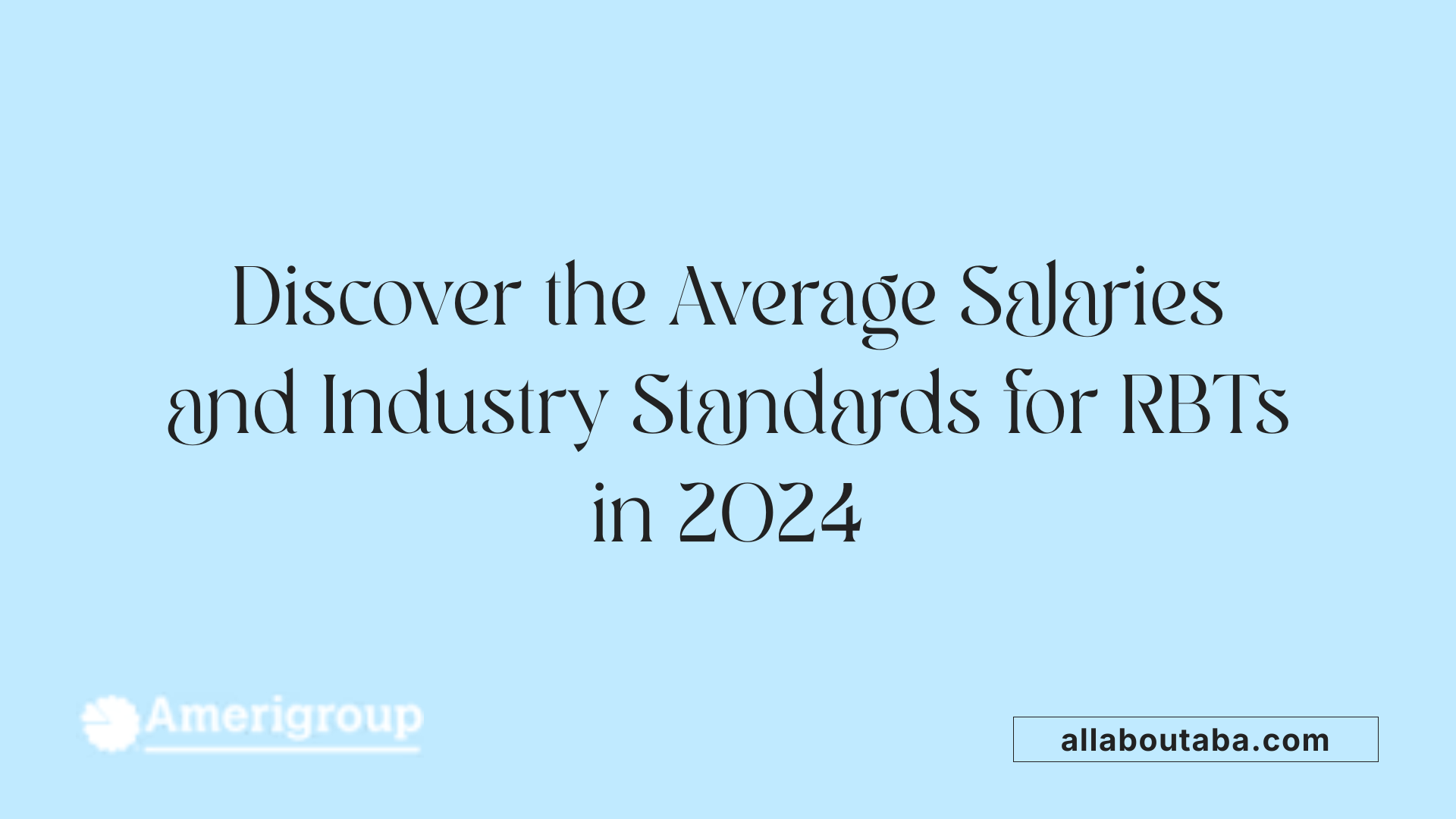Average Registered Behavior Technician (RBT) Salary
A Comprehensive Look at RBT Salaries Across the U.S.
Registered Behavior Technicians (RBTs) play a crucial role in delivering Applied Behavior Analysis (ABA) therapy, especially for individuals with autism spectrum disorder. As demand for ABA services continues to grow, so does the interest in understanding how much RBTs earn. This article provides an in-depth exploration of average salaries, regional differences, influencing factors, and future earning potential for RBTs in the United States as of 2024.
Overview of RBT Salary Averages and Industry Standards

What is the typical salary for a Registered Behavior Technician (RBT)?
The salary of a Registered Behavior Technician (RBT) in the U.S. generally falls within a broad range. On average, RBTs earn about $54,000 per year. Entry-level positions start at around $47,000 annually, offering a launching point for those new to the field.
With more experience, RBTs can increase their earnings significantly. Advanced practitioners or those with specialized skills might earn more than $66,000 annually. This progression depends on factors such as certifications, skills, location, and additional education.
Salaries also differ by state. For example, Maryland's average RBT salary is approximately $42,515 annually, with an hourly median wage of about $20.44. Meanwhile, in urban Honolulu, HI, the average salary is $54,234 annually, and in Campbell, CA, it’s around $46,546.
According to recent data from November 2024, the average hourly wage across the U.S. is around $27.24. Entry-level wages typically start at about $20 per hour, but with experience, hourly pay can rise to about $25, or roughly $52,000 annually.
In addition to base salaries, earning certifications such as BCAT or CAS can boost income. Career growth opportunities are promising, especially for RBTs progressing to roles like BCBA, with salaries exceeding $80,000.
Demand for RBTs remains high due to field shortages and increasing need for ABA therapy, supporting job stability and potential salary growth.
| Location | Average Annual Salary | Hourly Rate | Additional Notes |
|---|---|---|---|
| U.S. (average) | $54,000 | $27.24 | Industry-wide average as of 2024 |
| Maryland | $42,515 | $20.44 | Slightly below national average |
| Honolulu, HI | $54,234 | $26.07 | High cost of living |
| Campbell, CA | $46,546 | $22.38 | Competitive market |
| Worcester, MA | $44,464 | $21.38 | Moderate cost of living |
| Baltimore, MD | $42,536 | $20.45 | Local market specifics |
| New York, NY | $42,350 | $20.36 | Urban setting |
How does experience affect salary?
Early-career RBTs, with less than one year of experience, make approximately $16.21/hour, translating to about $33,800 annually. As they gain experience, wages can increase to $20/hour, about $41,600 yearly.
Those with over 20 years of experience might earn more than $20/hour, emphasizing continuous growth potential.
Overall, the professional trajectory, certifications, and geographic location play major roles in salary progression for RBTs.
Influencing Factors on RBT Salaries and Career Advancement
What factors influence RBT salaries and career growth prospects?
Several elements play a role in shaping the earning potential and career paths of Registered Behavior Technicians (RBTs). Understanding these factors can help professionals maximize their income and opportunities for advancement.
Geographic location and cost of living are among the most significant influences. In high-cost areas like California, New York, and Hawaii, salaries tend to be higher to compensate for the increased living expenses. For example, in Honolulu, HI, the average annual salary is approximately $54,234, while Maryland's average is about $42,515, slightly below the national average of $54,000.
Experience and educational certifications greatly impact pay. Entry-level RBTs start at around $47,000 per year, while experienced practitioners can earn over $66,000 annually. Certification upgrades, such as obtaining a BCBA or CAS, can further boost earnings and open doors to higher-paying roles.
Work setting and employer type also matter. Positions in private clinics often offer higher wages compared to schools or in-home settings. For instance, clinic-based roles in urban areas like Campbell, CA, pay around $46,546 annually, whereas school-based or community roles might offer less.
Additional education and specialization are associated with increased salaries. Higher degrees and specialized training not only improve skills but also position RBTs for promotions and leadership roles within behavioral health organizations.
Market demand and regional supply influence job stability and salary. The current positive outlook, characterized by high demand and shortages in many areas, suggests that RBTs can expect steady job growth and salary increases over time.
In summary, RBTs aiming to enhance their earnings should consider relocating to high-demand areas, pursuing further certifications, gaining experience, and exploring various work environments. These strategies collectively help build a more lucrative and sustainable career in behavioral therapy.
Regional Salary Variations and Their Impact

How does RBT salary vary across different regions or states?
RBT salaries tend to fluctuate quite a bit depending on the location within the United States. Factors like demand for ABA therapy, cost of living, and regional economic conditions influence pay levels. For example, in states like California and Massachusetts, RBTs earn higher salaries—averaging around $46,546 to $54,234 annually—due to the high demand and higher living costs.
In contrast, states such as Maryland offer somewhat lower average salaries, with RBTs earning around $42,515 annually, and the median hourly rate is approximately $20.44. However, the higher cost of living in some areas balances this lower pay.
Urban versus rural differences
Urban centers often feature higher salaries due to increased demand for services and greater job opportunities. For instance, in Honolulu, HI, the average annual salary reaches about $54,234, and in Campbell, CA, around $46,546. Rural areas may see slightly lower wages, reflecting differences in demand and the local healthcare infrastructure.
Cost of living considerations
While some regions offer higher salaries, the cost of living significantly impacts the overall value of these wages. For example, even though Maryland's average salary is below the national average, the higher living costs in the state help balance wages and expenses.
Top-paying states for RBTs
States like California, New York, and Massachusetts tend to pay above the national average, sometimes exceeding $50,000 per year. Other locations, such as Honolulu, HI, also offer competitive salaries. Overall, geographic location is a major factor influencing RBT earning potential, combined with factors like experience and specialization.
| Region/State | Average Salary | Hourly Rate | Additional Details |
|---|---|---|---|
| California (Campbell) | $46,546 annually | $22.38 | High demand, urban setting |
| Maryland | $42,515 annually | $20.44 | Lower than national average, balanced by higher living costs |
| Honolulu, HI | $54,234 annually | $26.07 | Coastal city, high pay and living costs |
| Worcester, MA | $44,464 annually | $21.38 | Northeastern location, competitive salaries |
| New York, NY | $42,350 annually | $20.36 | Dense urban environment, high demand |
This variation highlights that location influences earning potential significantly, and professionals may consider geographic factors carefully when planning their careers.
The Earning Potential and Career Growth Pathways for RBTs

What is the earning potential for Registered Behavior Technicians?
The earning potential for Registered Behavior Technicians (RBTs) varies depending on several factors including experience, location, certifications, and employer demand. In the United States, the average annual salary hovers around $54,000, with entry-level positions starting closer to $47,000 per year.
As RBTs gain more experience, their wages can increase significantly. Those with advanced experience can earn more than $66,000 annually. Hourly, the pay ranges from approximately $20 for entry-level roles to over $25 for more experienced RBTs, translating into annual salaries near $52,000.
Geographic location plays a notable role. In urban areas like Honolulu, HI, the average salary is around $54,200 yearly, whereas in states like Maryland, the average is about $42,500—slightly below the national average but balanced by the higher living costs.
Salary progression over time
Starting as an entry-level RBT, wages typically begin at around $20 per hour. With experience spanning a few years, hourly wages can reach around $25, resulting in better annual salaries.
Data indicate that RBTs with more than 20 years of experience can earn approximately $20/hour, with some regions or roles offering more.
| Years of Experience | Typical Hourly Rate | Approximate Annual Salary | Additional Notes |
|---|---|---|---|
| Less than 1 year | $16.21 | $33,700 | Entry level, starting salary |
| 1-5 years | $20 to $22 | $41,600 to $45,760 | Mid-level, more skills |
| 5-10 years | $22 to $24 | $45,760 to $49,920 | Increased responsibilities |
| 10+ years | $20 to $25 | $41,600 to $52,000 | Experienced professionals |
Impact of additional certifications
Obtaining certifications like BCAT (Behavior Analysis Certification) or CAS (Certified Autism Specialist) can lead to higher salaries. These additional qualifications often open doors to leadership roles, specialization, and increased pay.
For example, RBTs who earn certifications such as BCBA (Board Certified Behavior Analyst) can see their salaries rise substantially, sometimes exceeding $80,000 annually, especially when combined with advanced degrees and years of experience.
Career advancement options
Starting as an RBT provides a stepping stone toward more advanced roles. Progressing to a BCBA or BCaBA (Board Certified Assistant Behavior Analyst) can significantly boost earning potential.
Career growth often involves gaining additional education, such as master's degrees in behavioral analysis or related fields. These qualifications qualify professionals for supervisory or managerial roles, which offer higher salaries and more responsibility.
Salary ceilings and future prospects
While certifications such as the RBT have salary caps on their own, moving into roles like BCBA offers higher earning potential. Salaries for BCBAs can surpass $80,000, with some experienced professionals earning over $100,000.
The demand for behavior analysts continues to grow, driven by increased awareness and the need for autism and behavioral intervention services. Job stability and positive growth prospects make this a promising career path for RBTs looking to advance.
| Role | Average Salary | Potential Growth | Notes |
|---|---|---|---|
| RBT | $54,000/year | Entry-level to experienced | Starting point |
| BCaBA | $70,000/year | Mid-tier | Requires certification |
| BCBA | $80,000+ per year | Advanced | Higher education required |
| Supervisor/Manager | $100,000+ | Top-tier | Leadership positions |
This field offers a rewarding career trajectory for those committed to growing their skills and credentials, with ample opportunities for salary increases and professional development.
Impact of Certifications and Education on Salary Growth

What is the value of additional certifications like BCAT and CAS?
Certifications such as the Behavior Analyst Certification Certification (BCAT) and Clinical Autism Specialist (CAS) can significantly enhance an RBT’s earning potential. These credentials demonstrate specialized knowledge and dedication to the field, enabling RBTs to qualify for higher-paying roles or more specialized positions. Employers often prefer or require such certifications for advanced responsibilities, which come with increased compensation.
How does higher education influence salary?
While the RBT credential itself has a salary cap, pursuing higher education like a Master's degree in Applied Behavior Analysis (ABA) or related fields opens doors to career advancement. Advanced degrees can lead to roles such as Board Certified Behavior Analyst (BCBA), which typically earn substantially higher salaries—sometimes exceeding $80,000 annually. Continued education not only boosts earning potential but also enhances job security and opportunities for leadership roles.
What is the role of continuing education and specialization?
Ongoing training and specialization in areas such as crisis intervention, advanced behavioral strategies, or specific populations (e.g., adolescents or adults) allow RBTs to expand their skill set. Specialization often results in higher wages because it meets the growing demand for tailored behavioral services. Employers value RBTs who invest in their professional development, recognizing these efforts with salary increases.
How does salary change with advanced qualifications?
Attaining higher certifications and education levels correlates with significant salary boosts. Entry-level RBTs start around $20 per hour, or approximately $47,000 annually, but those with advanced credentials and experience can earn over $66,000 annually. In addition to higher pay, advanced qualifications often lead to greater job stability, more responsibilities, and upward mobility.
In summary, adding certifications like BCAT or CAS, pursuing higher education, and engaging in continuous specialization efforts substantially influence an RBT’s earning capacity. The combination of geographic advantages, experience, and advanced qualifications paves the way for sustained career growth and increased income in the field of ABA therapy.
Job Growth Trends and Future Outlook for RBTs
What is the earning potential for Registered Behavior Technicians?
The earning potential for RBTs can vary based on multiple factors including experience, location, and additional certifications. On average, in the United States, RBTs earn between $40,000 and $60,000 annually. Entry-level positions often start around $30,000 to $47,000, while those with more experience and advanced skills can earn over $70,000 per year, especially in high-demand states like California, New York, and Hawaii.
Gaining additional credentials, such as becoming a Board Certified Behavior Analyst (BCBA), can lead to higher salaries and better career opportunities. With experience, salaries tend to increase, making this a promising field for long-term career growth.
Projected job growth rates
The demand for RBTs is projected to grow significantly in the coming years. This growth is driven by an increasing awareness of autism spectrum disorder (ASD) and other behavioral conditions, along with a rising focus on early intervention and evidence-based therapies. Industry data suggests that job prospects for RBTs are favorable, with higher than average growth rates expected across many states.
Market demand and shortages
Demand for ABA therapy and trained RBTs remains high, leading to shortages in some regions. This scarcity of qualified professionals ensures stability and job security for RBTs. Employers are continually seeking qualified individuals, which can translate into attractive employment packages and flexible working conditions.
Job security and stability
The shortage of qualified RBTs coupled with increasing demand for behavioral health services contributes to strong job security. As the need for ABA therapy grows, RBTs are likely to enjoy consistent employment opportunities and potential wage increases.
Long-term career prospects
While RBT positions serve as an entry point into the field of applied behavior analysis, long-term prospects include advancement into roles such as BCBA or BCaBA, which come with higher earning potential—sometimes exceeding $80,000 annually. Continuing education, certifications, and experience can open doors to supervisory roles, research positions, and specialized clinical settings.
| Location | Average Salary | Hourly Rate | Notable Factors |
|---|---|---|---|
| United States | $54,000 | $27.24 | Demand varies by state and city; higher compensation in urban and high-demand regions |
| Maryland | $42,515 | $20.44 | Slightly below national average but balanced by higher cost of living |
| Hawaii (Honolulu) | $54,234 | $26.07 | High cost of living, competitive salaries |
| California (Campbell) | $46,546 | $22.38 | Attractive pay, competitive market |
| Massachusetts (Worcester) | $44,464 | $21.38 | Growing demand, good job prospects |
| New York | $42,350 | $20.36 | High population density, demand for ABA services |
Overall, the outlook for RBTs is optimistic. Increasing demand, better job stability, and opportunities for career advancement make this a promising field for those interested in behavioral health and therapy.
Salaries in Specific Urban Markets and Cost Impacts
How does RBT salary vary across different regions or states?
RBT salaries differ widely depending on geographic location and regional demand. For example, in urban areas like Honolulu, HI, the average annual salary is about $54,234, which translates to an hourly rate of roughly $26.07. Similarly, in Campbell, CA, the average salary reaches around $46,546 annually, with an hourly wage of approximately $22.38. Maryland cities, such as Baltimore, offer slightly lower salaries, averaging about $42,536 annually or $20.45 per hour.
States with higher costs of living, such as California and Massachusetts, often have higher salary ranges to match expenses. In contrast, some areas in the Midwest and Southeast may feature lower salaries, but these are balanced against lower living costs. Overall, the data shows that urban settings tend to provide higher salaries, reflecting increased demand and higher living expenses.
Urban salaries versus rural
There is a notable difference between salaries earned in urban versus rural areas. Urban markets usually offer higher wages due to greater demand for ABA therapy services, while rural regions might have fewer job opportunities and offer slightly lower pay. This disparity is often offset by lower costs of living in rural locations.
Cost of living adjustments
When comparing salaries across regions, considering the cost of living is crucial. For example, even if a city pays more, high housing, transportation, and everyday expenses can offset the higher wage. Conversely, in areas with lower housing costs, a lower salary might still afford a comfortable lifestyle.
Examples of top cities like Honolulu, CA, MA
- Honolulu, HI: $54,234 annually, $26.07/hour
- Campbell, CA: $46,546 annually, $22.38/hour
- Worcester, MA: $44,464 annually, $21.38/hour
- Baltimore, MD: $42,536 annually, $20.45/hour
- New York, NY: $42,350 annually, $20.36/hour
These cities exemplify how location influences salary, often correlating with higher costs of living. The higher wages in these urban centers reflect the demand for qualified RBTs and the economic strength of these markets.
Salary comparisons
| City | Average Salary | Hourly Rate | Notes |
|---|---|---|---|
| Honolulu, HI | $54,234 | $26.07 | High costs of living, strong market demand |
| Campbell, CA | $46,546 | $22.38 | California's higher salary averages |
| Worcester, MA | $44,464 | $21.38 | Moderate cost of living, steady demand |
| Baltimore, MD | $42,536 | $20.45 | Slightly below national average, urban area |
| New York, NY | $42,350 | $20.36 | High demand, very competitive job market |
Understanding these regional distinctions helps aspiring RBTs choose where to seek employment based on salary and cost of living factors. Overall, while urban centers offer higher pay, balancing salaries with living expenses is essential for making informed career decisions.
Summary and Key Takeaways for RBT Salaries in 2024
The average salary for a Registered Behavior Technician (RBT) in the U.S. is roughly $54,000 annually, though this varies based on experience, location, and certifications. Entry-level salaries generally start at around $47,000 per year, with those gaining advanced experience earning over $66,000.
Regionally, salary differences are notable. For example, Maryland's average RBT salary is about $42,515, slightly below the national average, but cities like Honolulu offer salaries around $54,234. In New York, the average is approximately $48,157, with hourly rates typically around $20.
Experience significantly impacts earnings. RBTs with less than one year of experience earn roughly $16.21 per hour, while those with over 20 years can make $20 or more an hour. Hourly wages across the country range from $13.94 up to $43.27, according to ZipRecruiter.
Career growth prospects are promising. The demand for RBTs remains high, with shortages driving positive job security and stability. Certification upgrades, such as obtaining a BCAT or CAS, and further education can lead to notable salary increases. For those advancing to roles like BCBA, salaries can exceed $80,000 annually.
Overall, the field offers strong opportunities for growth, especially for experienced professionals and those in high-demand areas. Aspiring RBTs should consider gaining additional certifications and experience to maximize their earning potential and career stability.
In Summary: Navigating the RBT Salary Landscape in 2024
The salary landscape for Registered Behavior Technicians is diverse and influenced by multiple factors, including location, experience, and education. While the national average hovers around $54,000, top-paying states and urban centers offer significantly higher wages, especially for those with advanced certifications or specialized skills. The field continues to grow rapidly, with strong job prospects and increasing demand, promising upward earning potential in the coming years. For aspiring RBTs, strategic choices in geographic location, gaining certifications, and accumulating experience can lead to a rewarding and financially viable career in behavioral health.
References
- Average Registered Behavior Technician (RBT) Salary
- Registered Behavior Technician Salary in Maryland - All Star ABA
- How much does an RBT make? Salary, hourly, benefits...
- Average Registered Behavior Technician (RBT) Salary
- RBT Certification Salary: How Much Can You Earn in 2025?
- Average Registered Behavior Technician (RBT) Salary
- How much does an RBT make? Salary, hourly, benefits...
- Average Registered Behavior Technician (RBT) Salary
- Understanding the Salary for Behavior Technicians: An In-Depth ...
- RBT Certification Salary: What to Expect - Affinity ABC
Other articles
Recent articles

Best Practices For Transitioning Autistic Children Into New Schools

Autism And Time Management Challenges In Adulthood

The Role Of Visual Arts In Autism Communication Development

How To Address Tactile Defensiveness In Autism

Best Practices For Telehealth Autism Therapy

How To Help Autistic Children Develop Friendship Skills

How Schools Can Support Autistic Students In Career Prep

Best Strategies For Autism-Friendly Event Planning

Understanding Noncontingent Reinforcement In Autism Behavior Plans

How Drama Therapy Benefits Autistic Individuals

Best Practices For Autism-Friendly Fitness And Recreation Centers

Best Ways To Promote Healthy Social Media Use For Autistic Teens

How To Help Autistic Children Cope With Public Speaking

Autism And Strategies For Managing Unexpected Changes

Best Podcasts About Autism For Parents And Educators

Autism And The Impact Of Seasonal Changes On Behavior

The Role Of Diet In Managing Co-Occurring Conditions With Autism

Sleep Challenges In Autism And Practical Solutions

Best Ways To Build Daily Routines For Autistic Children

Best Practices For Supporting Autistic Entrepreneurs

Autism And Strategies For Navigating Large Social Gatherings

Adaptive Sports And Recreational Activities For People With Autism

Autism And The Benefits Of Story-Based Learning Activities

Understanding The Role Of Play In Autism Development

Autism And The Impact Of Environmental Noise On Learning

How To Create Autism-Friendly Community Spaces

Autism And Chronic Health Conditions: What To Know

The Role Of Care Managers In Autism Life Planning

How To Teach Social Boundaries To Autistic Children

How Autistic Individuals Experience Empathy Differently

How To Support Autistic Employees In Remote Work Settings

Autism And The Relationship Between Motor Skills And Learning

How To Create Community Resource Guides For Autism Families

How To Teach Daily Living Skills To Autistic Teens

Autism And The Impact Of Mind-Body Practices On Stress Reduction

Autism And The Benefits Of Outdoor Group Activities

How To Create Autism-Friendly Sensory Paths In Schools

Best Practices For Autism-Friendly Park And Recreation Areas

Autism And Strategies For Reducing School Refusal

Supporting Autistic Individuals In Public Speaking

The Role Of Diet In Managing Autism Symptoms

The Benefits Of Gardening Clubs For Autism Social Development

How To Prepare Autistic Children For Dental Visits

Autism And Employment: Career Paths That Work

Best Practices For Autism-Friendly Hotels And Lodging

The Impact Of Screen Time On Autism Development

Autism Screening Tools For Early Childhood

The Role Of Physical Exercise In Autism Therapy

Best Strategies For Supporting Autistic College Students

The Role Of Technology In Autism Early Detection

Sensory-Friendly Classroom Design Ideas For Autistic Students

The Role Of Speech Therapy In Building Social Communication Skills

Best Strategies For Handling Autistic Burnout In Adults

Autism And The Importance Of Predictability In Routine

Autism And Peer Education: Teaching Acceptance In Schools

Best Practices For Sensory-Friendly Libraries And Reading Rooms

Self-Advocacy Skills For Autistic Adults

The Role Of Technology In Autism Peer Communication

Promoting Physical Activity In Children With Autism

How To Prepare Autistic Children For Medical Procedures

The Role Of Social Media In Autism Advocacy And Awareness

The Impact Of Sensory Rooms In Public Facilities For Autism

How To Create An Autism-Friendly Holiday Celebration

Best Practices For Inclusive Education For Autistic Students

Autism And Mental Health: Recognizing Signs Of Distress

Best Practices For Sensory-Friendly Waiting Rooms

The Role Of Teachers In Early Autism Red Flag Identification

Autism-Friendly Housing Design Features

Autism-Friendly Housing Design Features

How Environmental Modifications Improve Autism Outcomes

Autism And Technology-Based Learning Tools

Supporting Autistic Children Through Changes In Routine

The Link Between Autism And Working Memory Challenges

Best Practices For Autism-Friendly Cooking Classes

Autism And The Benefits Of Structured Music Lessons

Best Books To Teach Kids About Autism Acceptance

Sensory Diets And Their Benefits For Autism Management

How To Prepare Autistic Teens For Driver’s Education

How To Teach Autistic Teens About Healthy Relationships

The Role Of Visual Prompts In Building Daily Habits For Autism

Addressing Sleep Regression In Children With Autism

Understanding Social Stories And How They Help Autistic Children

Navigating Insurance Coverage For Autism Therapy Services

How To Prepare Autistic Adults For Independent Travel

Supporting Autistic Individuals In Volunteer Work

How Mindfulness Practices Can Support Autism Well-Being

Understanding Hyperfocus And Special Interests In Autism

Understanding Stimming As A Self-Regulation Tool

Sensory-Based Interventions For Autism At Home

Best Ways To Introduce Self-Advocacy In Autistic Teens

Best Ways To Support Autistic Employees In Customer Service Roles

Best Practices For Autism-Friendly Volunteer Programs

Autism And The Benefits Of Sensory Play For Emotional Growth

Autism And Strategies For Building Peer Relationships

Understanding How Autism Affects Memory Processing

Autism And Strategies For Building Coping Skills In Teens

The Role Of Parent Training In Autism Intervention Programs

Autism-Friendly Workplace Accommodations

Using Visual Timers For Autism Time Management

What Is ABA Therapy?
We’re All About You, Your Family, and Your Child

